Ciclo de vida de la mariquita – Embark on a captivating exploration of the ladybug life cycle, a journey of transformation and ecological significance. From the humble egg to the vibrant adult, each stage unveils a unique aspect of these beloved insects.
Ladybugs, also known as ladybird beetles, are fascinating creatures that play a crucial role in our ecosystems. Join us as we delve into their physical characteristics, habitat preferences, feeding habits, reproductive strategies, and defense mechanisms, gaining a deeper appreciation for these remarkable insects.
Lifecycle Stages
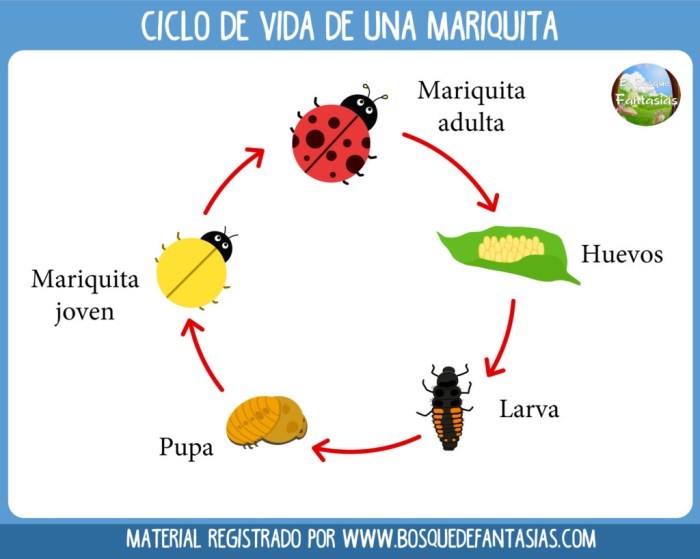
The life cycle of a ladybug, also known as a ladybird beetle, consists of four distinct stages: egg, larva, pupa, and adult.
The duration of each stage and the specific characteristics of the ladybug vary depending on the species and environmental conditions.
Egg
- Female ladybugs lay small, oval-shaped eggs in clusters on the underside of leaves or other sheltered locations.
- The eggs are typically yellow or orange in color and have a smooth surface.
- The incubation period for ladybug eggs ranges from a few days to several weeks, depending on the species and temperature.
Larva
- When the eggs hatch, they release tiny, elongated larvae.
- The larvae are typically black or gray with orange or yellow spots and have six legs.
- The larvae feed on aphids, scale insects, and other small insects.
- The larval stage lasts for several weeks, during which time the larvae molt several times as they grow.
Pupa
- When the larva is fully grown, it attaches itself to a leaf or other surface and enters the pupal stage.
- The pupa is a non-feeding stage during which the larva undergoes a dramatic transformation into an adult ladybug.
- The pupa is typically oval-shaped and has a smooth, shiny surface.
- The pupal stage lasts for several days to several weeks, depending on the species and temperature.
Adult
- When the adult ladybug emerges from the pupa, it is fully formed and ready to mate and lay eggs.
- Adult ladybugs are typically red, orange, or yellow with black spots, although some species may have different color patterns.
- Adult ladybugs feed on aphids, scale insects, and other small insects.
- The adult stage can last for several months, depending on the species and environmental conditions.
| Stage | Description |
|---|---|
| Egg | Small, oval-shaped eggs laid in clusters. |
| Larva | Tiny, elongated larvae with six legs that feed on insects. |
| Pupa | Non-feeding stage during which the larva transforms into an adult. |
| Adult | Fully formed ladybug that mates and lays eggs. |
Physical Characteristics
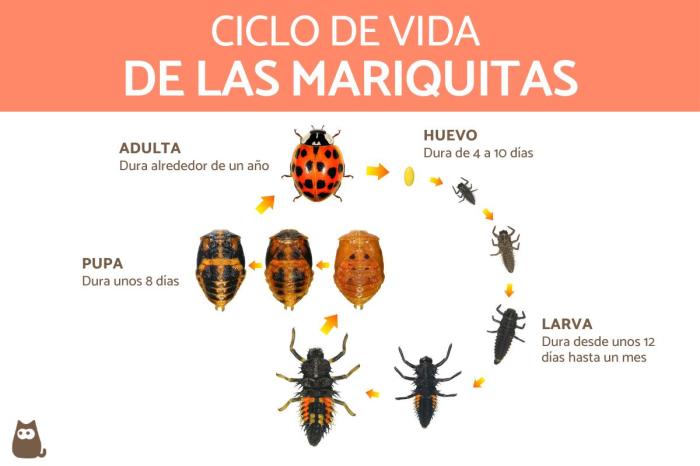
Ladybugs, also known as lady beetles or ladybird beetles, are characterized by their distinctive physical features. These beetles exhibit variations in size, shape, and coloration, with different species showcasing unique attributes.
The life cycle of a ladybug is quite fascinating. It undergoes complete metamorphosis, going through four distinct stages: egg, larva, pupa, and adult. The larva looks like a tiny alligator and feeds on aphids. Incidentally, have you ever wondered what mphj 100 120 140 160 stands for? Click here to find out.
Returning to our ladybug, the pupa stage is a period of transformation, where the larva changes into an adult ladybug. The adult ladybug emerges with its characteristic red and black spots.
Generally, ladybugs are small insects, typically ranging from 1 to 10 millimeters in length. Their bodies are typically oval or rounded in shape, providing them with protection and maneuverability. The most striking feature of ladybugs is their coloration, which often involves bright and contrasting colors.
Coloration
Ladybugs display a diverse array of colors, with red, orange, and yellow being the most common. These vibrant hues serve as a warning signal to predators, indicating their unpalatability due to the presence of toxic chemicals in their bodies.
However, not all ladybugs exhibit these bright colors. Some species have evolved to have more subdued coloration, such as brown or black, which provides them with camouflage in their natural habitats.
Variations Among Species
The physical characteristics of ladybugs vary significantly among different species. Some notable variations include:
- Size:Ladybugs can range in size from the tiny Scymnus impexus, measuring around 1 millimeter in length, to the larger Harmonia axyridis, which can reach up to 10 millimeters in length.
- Shape:While most ladybugs have an oval or rounded shape, some species exhibit more elongated or flattened bodies, such as the Coccinella septempunctata, which has a more elongated oval shape.
- Coloration:The coloration of ladybugs varies greatly among species. While many species exhibit the classic red or orange coloration with black spots, others display different color combinations, such as yellow with black spots, or even solid black or brown coloration.
| Species | Size (mm) | Shape | Coloration |
|---|---|---|---|
| Coccinella septempunctata | 5-8 | Elongated oval | Red with seven black spots |
| Harmonia axyridis | 7-10 | Oval | Red or orange with variable black spots |
| Scymnus impexus | 1-2 | Rounded | Black or brown |
Habitat and Distribution
Ladybugs are highly adaptable insects that can be found in various habitats around the world. They are commonly found in grasslands, meadows, forests, gardens, and agricultural fields. Ladybugs prefer environments with an abundance of vegetation, which provides them with shelter and food.
They are also often found in areas with high aphid populations, as aphids are their primary prey.
Geographic Distribution
Ladybugs have a wide geographic distribution and can be found on all continents except Antarctica. They are most commonly found in temperate regions, but some species can also be found in tropical and subtropical areas. The global distribution of ladybugs is illustrated in the map below.[Image:
A map showing the global distribution of ladybugs]
Diet and Feeding Habits
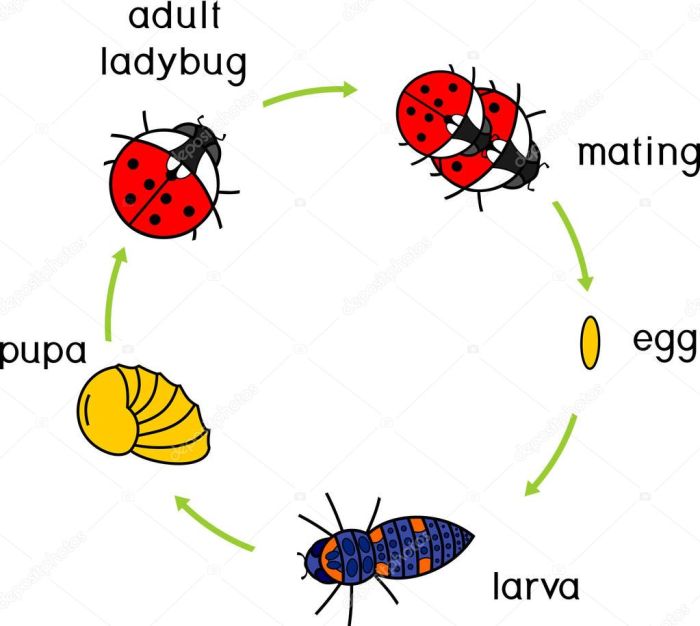
Ladybugs are voracious predators, consuming a wide variety of insects. They primarily feed on aphids, which are small, sap-sucking pests that can cause significant damage to plants. Ladybugs also prey on other soft-bodied insects, such as mealybugs, scale insects, and thrips.
Ladybugs locate their prey using their keen sense of smell. Once they find a suitable target, they will use their sharp mandibles to pierce the insect’s exoskeleton and inject a digestive enzyme. The enzyme breaks down the insect’s internal organs, allowing the ladybug to suck out the liquefied contents.
Role of Ladybugs in Pest Control, Ciclo de vida de la mariquita
Ladybugs are considered beneficial insects due to their voracious appetite for pests. By consuming large numbers of aphids and other pests, ladybugs help to protect plants and crops from damage. This makes them a valuable asset in both agricultural and horticultural settings.
Types of Insects Preyed on by Ladybugs
- Aphids
- Mealybugs
- Scale insects
- Thrips
- Whiteflies
- Spider mites
- Leafhoppers
- Psyllids
- Coccoids
Reproduction and Mating: Ciclo De Vida De La Mariquita
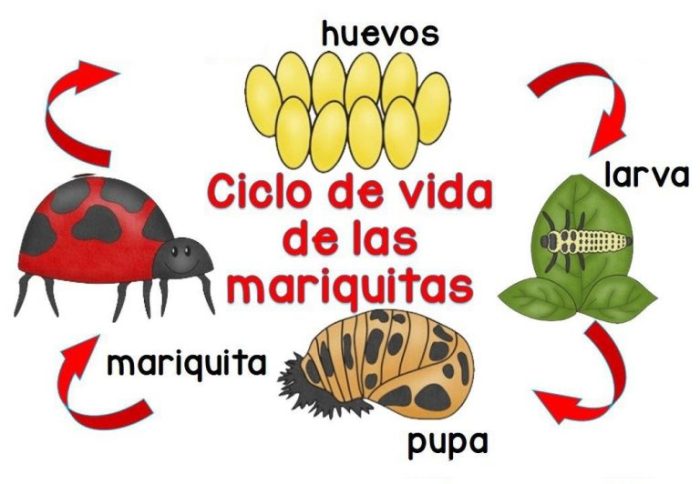
Ladybugs undergo sexual reproduction, involving mating between males and females. The reproductive cycle consists of several stages:
Courtship and Mating
Ladybugs engage in courtship behaviors to attract potential mates. Males typically display their bright colors and perform dances or release pheromones to attract females. When a female is receptive, the male mounts her back and clasps her with his genitalia.
Mating can last for several hours, during which sperm is transferred from the male to the female.
Egg-laying
After mating, females lay clusters of eggs on suitable surfaces, such as leaves, stems, or crevices. The eggs are typically oval or elongated and vary in color depending on the species. The number of eggs laid by a single female can range from a few dozen to several hundred.
Factors Influencing Reproduction
Ladybug reproduction is influenced by various factors, including:
Temperature
Ladybugs are most active and reproductive during warm temperatures.
Food availability
Adequate food sources are essential for egg production and larval development.
Habitat quality
Suitable habitats with ample vegetation and shelter support ladybug populations.
Predation
Ladybugs face predation from birds, insects, and other animals, which can affect their reproductive success.
Predators and Defenses
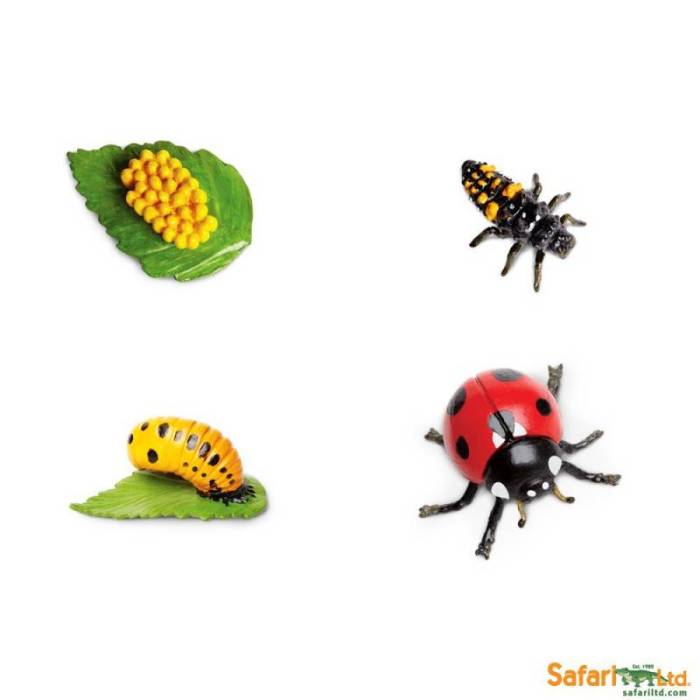
Ladybugs have a variety of natural predators, including birds, spiders, frogs, and other insects. To protect themselves from these predators, ladybugs have evolved several defense mechanisms.
Chemical Defenses
Ladybugs produce a foul-tasting and toxic substance called hemolymph, which they can release when threatened. This substance deters many predators from eating them.
FAQ Overview
How long does a ladybug live?
The average lifespan of a ladybug is one to two years.
What do ladybugs eat?
Ladybugs are primarily carnivorous, feeding on aphids, scale insects, and other small pests.
Are ladybugs beneficial insects?
Yes, ladybugs are considered beneficial insects as they help control populations of harmful pests.